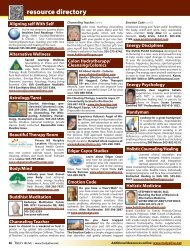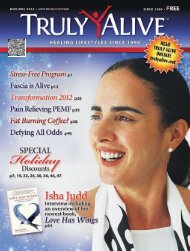reading - Truly Alive Magazine
reading - Truly Alive Magazine
reading - Truly Alive Magazine
Create successful ePaper yourself
Turn your PDF publications into a flip-book with our unique Google optimized e-Paper software.
(converted by the organisms in our mouths and intestinal<br />
tracts). Mercury deforms developing brain architecture<br />
by altering the maturing and the migrating nerve cells, as<br />
well as interferes with the<br />
brain’s communication<br />
pathways, causing<br />
neurologic dysfunction,<br />
as well as nerve cell<br />
inflammation and<br />
eventual death, in both<br />
developing and mature<br />
nervous systems. Both<br />
forms of mercury<br />
continue accumulating<br />
throughout our lifetimes, prematurely aging our brains.<br />
Unfortunately, it is trending to create much earlier<br />
neurologic disease states in the younger generations,<br />
who are more genetically fragile to the neurotoxic effects<br />
both in the womb and postnatally to toxic stressors<br />
such as mercury. Such insults, combined with other<br />
neuroimmune stressors, e.g., food intolerances to a toxic,<br />
genetically altered, food supply, immunizations, clinically<br />
evasive low-grade infections, as well as electric pollution,<br />
all act as toxic burdens to the brain.<br />
Common sources of mercury exposure are:<br />
Coal burning power plants, Dental silver amalgams,<br />
Thermometers, Vaccinations, Contaminated fish,<br />
Exterior house paints, Germicidal agents and<br />
disinfectants, Insecticidal products, Seed preservatives,<br />
Wood preservatives, Chemical laboratories, Cosmetics.<br />
Note: Newer compact, energy-efficient fluorescent<br />
lights contain substantial mercury concentrations,<br />
making breakages with subsequent release a concerning<br />
source of exposure.<br />
Mercury and dental health:<br />
If you are like most Americans, you probably have<br />
mercury and/or other metal fillings in your mouth.<br />
Mercury fillings, also known as “silver fillings” or<br />
“amalgams,” are the most common fillings in the world.<br />
Called silver because of their color, they actually contain<br />
45 to 52 % mercury and only 30% silver. Copper, tin,<br />
silver and zinc make up the remaining volume. Scientific<br />
research has demonstrated that mercury, even in small<br />
amounts, can damage the brain, heart, lungs, liver,<br />
kidneys, thyroid gland, pituitary gland, adrenal gland,<br />
cells, enzymes and hormones, and suppress the body’s<br />
immune system. Mercury is continually released from<br />
dental fillings in the form of mercury vapor and abraded<br />
particles. Mercury vapors can increase as much as 15-fold<br />
by chewing, brushing, drinking hot liquids, etc. The World<br />
Health Organization recently concluded that the daily<br />
intake of mercury from amalgam dental fillings exceeded<br />
the combined daily intake of mercury derived from air,<br />
water and food (including fish). In human autopsy studies,<br />
it has been found that there is a direct correlation between<br />
the amount of mercury found in the brain and the number<br />
and surfaces of mercury fillings in teeth.<br />
A call to action: What are your treatment options?<br />
Begin by identifying your past and any ongoing mercury<br />
exposures, as well as your bodies’ current toxic burden. Then<br />
become informed on appropriate avoidance behaviors, as<br />
well as safe routes of mercury<br />
removal from your body and<br />
completely avoiding mercury<br />
amalgam fillings in the future.<br />
There are alternative techniques<br />
to treat metal toxicity<br />
problems. For those mercury<br />
amalgams already placed,<br />
consider the safe removal<br />
with a biological dentist or<br />
specialist, followed by chelation<br />
therapy. If your mouth<br />
is already mercury-free, and<br />
you’ve established your toxic<br />
burden, chelation therapy options can be pursued.<br />
If you wish to be evaluated for a neurotoxic assessment, please<br />
contact our office at 505-503-8325 for an appointment.<br />
Read more articles online: by Pamela www.trulyalive.net<br />
Costello online: www.trulyalive.net<br />
<strong>Truly</strong> <strong>Alive</strong> | May/June 2013 15














